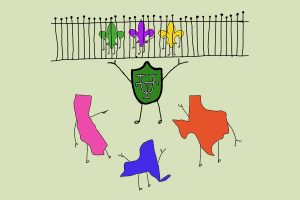In quest for Southern Ivy status, Tulane has only adopted its exclusive tendencies
February 20, 2019
As one of the top 50 most acclaimed universities in the U.S., Tulane University continuously accepts those students who are “the best and the brightest.” While this seems constructive for the university, admissions statistics paint an unseemly portrait of campus than what is aggressively promoted.

It is no lie that Tulane University has had a less than stellar history regarding its racial and socioeconomic diversity. Paul Tulane, the university’s founder himself, declared that Tulane should be for white students only. In a city that is proud of its multicultural heritage and history, Paul Tulane’s racism sticks out as a disgraceful sore thumb when compared to the wide breadth of the city’s cultures.
While Tulane University certainly no longer shares the position of its founder, the ethnic, geographic and socioeconomic distribution among its students today clearly details a tainted history of discrimination.
As a whole, the undergraduate population is made up of almost 74 percent Caucasian students and the remaining 26 percent students of color. This year, however, the Class of 2022 was lauded as the “most diverse” class in Tulane’s history, with 22 percent of its first-year students being students of color. Compared to other schools, the percentage of racial minority students in our freshman class is still shockingly meager.
Harvard University’s Class of 2022 holds 52.7 percent, Princeton University 45 percent, Vanderbilt University 43.2 percent, Emory University 41.4 percent and Tufts University at 37.1 percent. While “Southern Ivy” is not an official designation, it’s a phrase commonly used for schools comparable to Ivy League universities which are located outside the Northeast. When compared to these major Ivy League institutions, and their similar southern counterparts, Tulane falls drastically behind them in racial diversity, despite the fact that many are of the same caliber in terms of education and prestige.
Another point of concern for the university is the lack of diversity in median household income of its student body. It is no lie that Tulane holds stereotypes for attracting wealthy students. According to a statistic from The New York Times, “the median family income of a student from Tulane is $180,700, and 69 percent come from the top 20 percent.”
That number, however, is about four times the median family income of Louisiana residents, which is approximately $45,146. As a result, Tulane marginalizes students from the state in which it is located in, with a projected cost of attendance totaling $74,860.
While other elite universities have similar tuition rates, and their student bodies hold relatively equal median family incomes, their ability to attract, and accommodate, students from their home states is much higher than Tulane’s.
Tulane’s undergraduate program attracts 16.72 percent of its students from the New Orleans area and 4.58 percent from other areas in Louisiana, which makes 21.3 percent of Tulane’s undergraduate population from Louisiana.
As the university continues its march towards “Southern Ivy” status. It is clear that the university has taken many of the negative qualities of the Ivy culture without offering many of the benefits of said institutions.









Reader • Nov 3, 2019 at 12:50 pm
Tulane is hardly on the level of any of the institutions mentioned. Tulane doesn’t attract much diversity b/c mostly rich white top 25 college rejects enjoy the idea of being a Tulane student
Tammy • Mar 14, 2019 at 4:39 pm
Exactly, and that’s what I mean about securing housing for disadvantaged students who WANT To STAY on campus but Tulane housing policies or horrible stressful leaving the family and students to worry about where they are going to live. See comment under is Tulane meeting the residence needs of ALL students.
Andrew • Mar 1, 2019 at 6:36 am
THANKS
Andrew • Mar 1, 2019 at 6:35 am
And? The point is that Tulane needs to admit more students of colour, yes? Tulane is going through a transition, in transforming itself into a top tiered bastion of learning in a state where education is not valued. Diversity is important, but takes time. And frankly, all the cities providing sanitary for the mentioned schools of higher learning far exceed New Orleans, and certainly Louisiana in terms of nurturing a pool of qualified “disadvantaged” students. So give Tulane and New Orleans some time – things are changing.